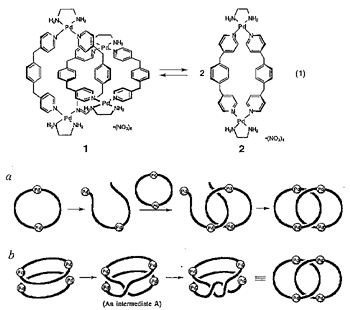
Makoto FUJITA, Fumiaki IBUKURO,* Hiroko SEKI,** Osamu KAMO,*** Mamoru IMANARI*** and Katsuyuki OGURA** (*Graduate Univ. for Advanced Studies, **Chiba University, ***JEOL Ltd.)
[J. Am. Chem. Soc. 118, 899 (1996)]
Catenane 1 exists in rapid equilibrium with monomer ring 2 (eq 1, M. Fujita et al., Nature 367, 720 (1994)). A conventional explanation for the catenane formation involves dissociation of a ring at a Pd-N linkage, threading another ring on the thread, and reconnection of the ends of the thread (mechanism a in Scheme 1). However, the results of the present study negated this simple mechanism and strongly supported an alternative. Here we suggest that the rapid interconversion is explained in terms of ligand exchange between Pd-N bonds. More strictly, our proposed pathway leading to the catenane involves two sequential ligand exchanges between two molecular rings concomitant with a twisting of the rings around each other (mechanism b in Scheme 1).

Scheme 1. Possible Mechanisms for the Rapid Slippage of Two Molecular Rings: (a) Conventional Mechanism and (b) Ligand Exchange Mechanism